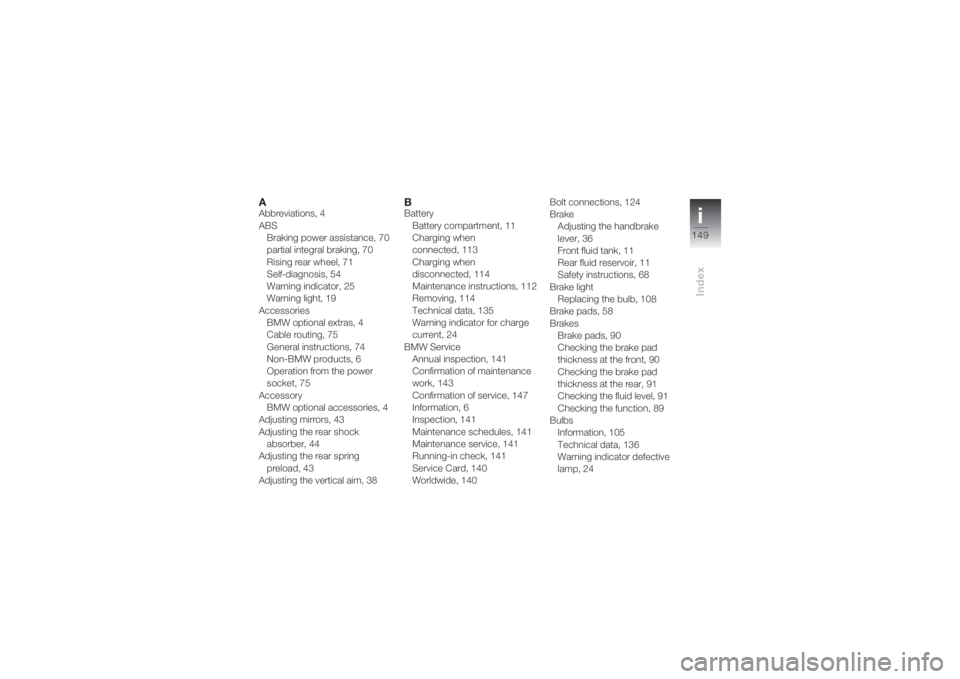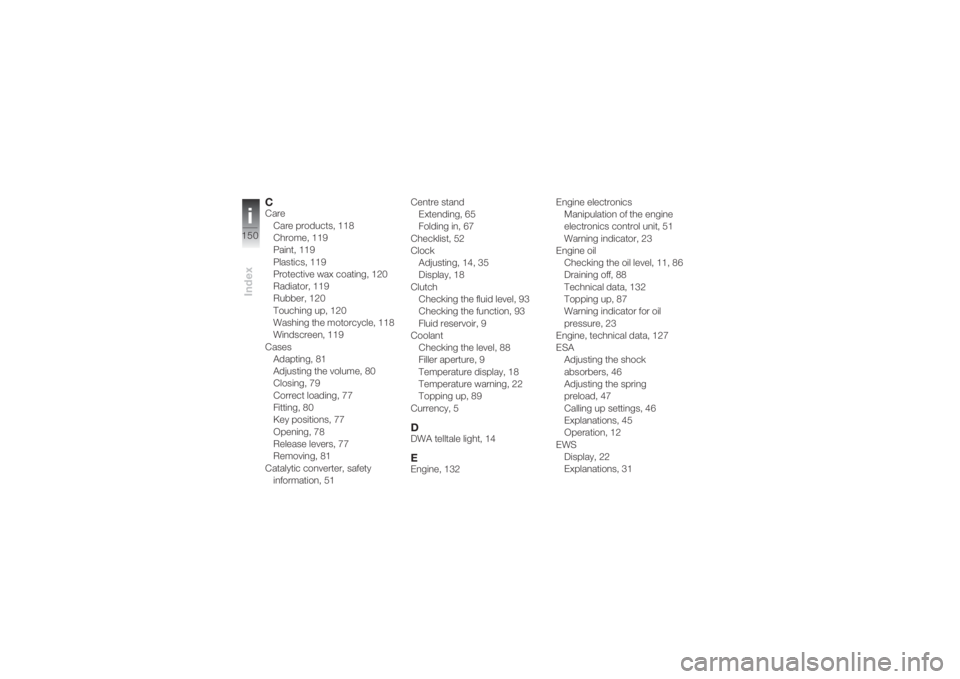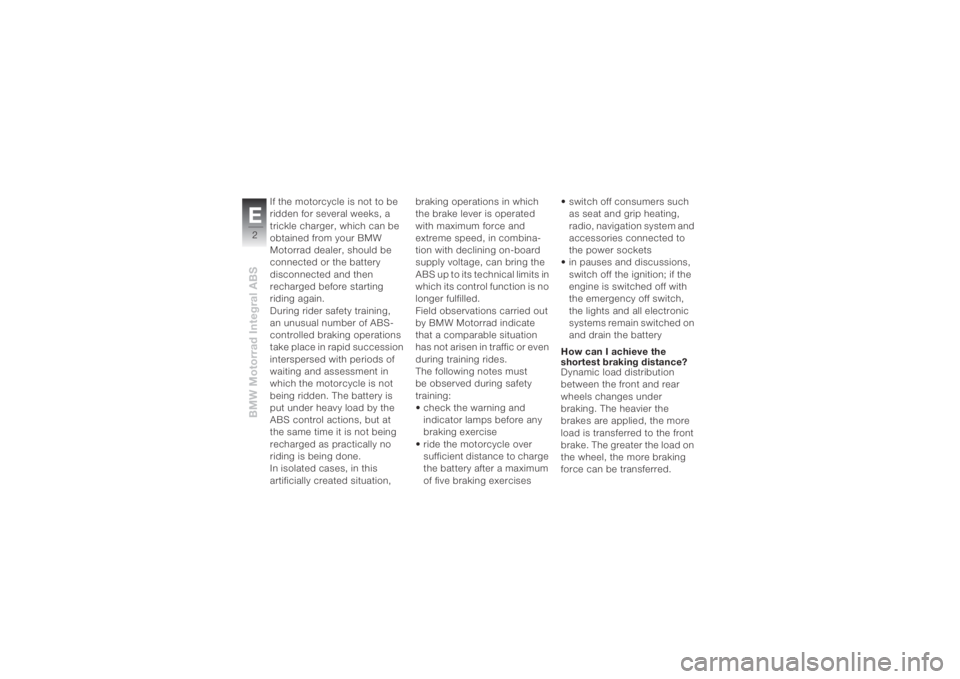Page 107 of 162
6105
Maintenance
• Place your left hand on the
left grab handle of the motor-
cycle 4, and your right hand
on the lever of the rear wheel
stand 5.
• Raise the motorcycle, simul-
taneously pressing the lever
downwards until the motor-
cycle stands vertically.• Press the lever onto the
ground.
BulbsInformation on bulbsThe failure of a bulb is sig-
nalled in the display by the
defective lamp symbol. If the
brake or rear light fails, the
general warning light also
lights up yellow.
If the rear light fails, the brake
light is used as a substitute in that the luminosity of the
second glow filament is
reduced to rear light level. Fail-
ure of the rear light is still
shown in the display.
In the event of a lamp
failure, there can be
problems seeing and being
seen.
Replace defective bulbs as
soon as possible; preferably
always carry appropriate
reserve lamps.c
You will find an overview
of the types of bulb used
on (
b 136).c
Page 151 of 162

i149
Index
AAbbreviations, 4
ABS
Braking power assistance, 70
partial integral braking, 70
Rising rear wheel, 71
Self-diagnosis, 54
Warning indicator, 25
Warning light, 19
Accessories
BMW optional extras, 4
Cable routing, 75
General instructions, 74
Non-BMW products, 6
Operation from the power
socket, 75
Accessory
BMW optional accessories, 4
Adjusting mirrors, 43
Adjusting the rear shock
absorber, 44
Adjusting the rear spring
preload, 43
Adjusting the vertical aim, 38
BBattery
Battery compartment, 11
Charging when
connected, 113
Charging when
disconnected, 114
Maintenance instructions, 112
Removing, 114
Technical data, 135
Warning indicator for charge
current, 24
BMW Service
Annual inspection, 141
Confirmation of maintenance
work, 143
Confirmation of service, 147
Information, 6
Inspection, 141
Maintenance schedules, 141
Maintenance service, 141
Running-in check, 141
Service Card, 140
Worldwide, 140Bolt connections, 124
Brake
Adjusting the handbrake
lever, 36
Front fluid tank, 11
Rear fluid reservoir, 11
Safety instructions, 68
Brake light
Replacing the bulb, 108
Brake pads, 58
Brakes
Brake pads, 90
Checking the brake pad
thickness at the front, 90
Checking the brake pad
thickness at the rear, 91
Checking the fluid level, 91
Checking the function, 89
Bulbs
Information, 105
Technical data, 136
Warning indicator defective
lamp, 24
Page 152 of 162

Indexi150
CCare
Care products, 118
Chrome, 119
Paint, 119
Plastics, 119
Protective wax coating, 120
Radiator, 119
Rubber, 120
Touching up, 120
Washing the motorcycle, 118
Windscreen, 119
Cases
Adapting, 81
Adjusting the volume, 80
Closing, 79
Correct loading, 77
Fitting, 80
Key positions, 77
Opening, 78
Release levers, 77
Removing, 81
Catalytic converter, safety
information, 51Centre stand
Extending, 65
Folding in, 67
Checklist, 52
Clock
Adjusting, 14, 35
Display, 18
Clutch
Checking the fluid level, 93
Checking the function, 93
Fluid reservoir, 9
Coolant
Checking the level, 88
Filler aperture, 9
Temperature display, 18
Temperature warning, 22
Topping up, 89
Currency, 5
DDWA telltale light, 14EEngine, 132Engine electronics
Manipulation of the engine
electronics control unit, 51
Warning indicator, 23
Engine oil
Checking the oil level, 11, 86
Draining off, 88
Technical data, 132
Topping up, 87
Warning indicator for oil
pressure, 23
Engine, technical data, 127
ESA
Adjusting the shock
absorbers, 46
Adjusting the spring
preload, 47
Calling up settings, 46
Explanations, 45
Operation, 12
EWS
Display, 22
Explanations, 31
Page 153 of 162
i151
Index
FFront-wheel stand, 103
Fuel
Filler aperture, 11
Fuel gauge, 18
Quality, 68, 134
Refuelling, 67
Reserve display, 22
Fuel tank capacity, 68
Fuses, 135GGear indicator, 18
Gearbox
Gear shifts, 59
Position on starting, 53
Technical data, 128
General view
Left side, 9
Right side, 11
Grip heating, 13, 35
HHandlebar controls
Left, 12
Right, 13
Hazard warning
flashers, 12, 32, 33
Headlight
Adjustment for right-hand/left-
hand traffic, 38
Overview, 15
Headlight flasher, 12, 37
Headlights
Adjusting the vertical aim, 9
Helmet holder, 9, 41
High-beam headlight
Bulb, 15
Replacing the bulb, 107
Switching on, 12, 37
Telltale light, 18
Horn, 12
IIgnition
Switching off, 30
Switching on, 30, 53
Inflation pressures, 126
Installing the battery, 115
Instrument cluster, 14JJump starting, 111KKeys
Ignition keys, 30
Replacement keys, 32
Kill switch, 13, 34LLaying up, 120
Low-beam headlight
Bulb, 15
Replacing the bulb, 106
Switching on, 37
Page 155 of 162
i153
Index
Frame and suspension, 129
Fuel and lubricants, 132
Information, 5
Power transmission, 128
Riding specifications, 138
Wheels, 131
Telltale lights, 14, 18
Tightening torques, 124
Toolkit, 11, 85
Tripmaster, 12, 18, 33
Turn indicator
Left, 12
Replacing the front bulb, 109
Replacing the rear bulb, 110
Right, 13
Turn indicators
Switching off, 13, 40
Switching on, 39
Telltale lights, 18
Type plate, 11
VVehicle identification number, 11WWarning indicators
Notes, 19
Overview, 20
Warning lights, 14, 18
Warnings, 4
Wheels
Checking the rims, 94
Checking the tread depth, 94
Checking the tyre pressure, 47
Fitting the front wheel, 97
Fitting the rear wheel, 100
Makes, 94
Removing the front wheel, 95
Removing the rear wheel, 99
Technical data, 131
Tyre pressures, 126
Page 160 of 162

BMW Motorrad Integral ABSE2
If the motorcycle is not to be
ridden for several weeks, a
trickle charger, which can be
obtained from your BMW
Motorrad dealer, should be
connected or the battery
disconnected and then
recharged before starting
riding again.
During rider safety training,
an unusual number of ABS-
controlled braking operations
take place in rapid succession
interspersed with periods of
waiting and assessment in
which the motorcycle is not
being ridden. The battery is
put under heavy load by the
ABS control actions, but at
the same time it is not being
recharged as practically no
riding is being done.
In isolated cases, in this
artificially created situation, braking operations in which
the brake lever is operated
with maximum force and
extreme speed, in combina-
tion with declining on-board
supply voltage, can bring the
ABS up to its technical limits in
which its control function is no
longer fulfilled.
Field observations carried out
by BMW Motorrad indicate
that a comparable situation
has not arisen in traffic or even
during training rides.
The following notes must
be observed during safety
training:
• check the warning and
indicator lamps before any
braking exercise
• ride the motorcycle over
sufficient distance to charge
the battery after a maximum
of five braking exercises• switch off consumers such
as seat and grip heating,
radio, navigation system and
accessories connected to
the power sockets
• in pauses and discussions,
switch off the ignition; if the
engine is switched off with
the emergency off switch,
the lights and all electronic
systems remain switched on
and drain the battery
How can I achieve the
shortest braking distance?
Dynamic load distribution
between the front and rear
wheels changes under
braking. The heavier the
brakes are applied, the more
load is transferred to the front
brake. The greater the load on
the wheel, the more braking
force can be transferred.Info_I_ABS_en_xx.fm Seite 2 Dienstag, 19. Juli 2005 2:48 14